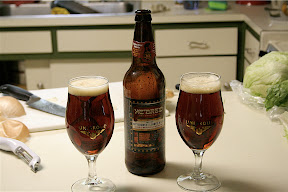They were both He'Brew beers: we drank a MONUMENTAL JEWBELATION, and a BITTERSWEET LENNY'S R.I.P.A..
In general, we start at the lighter-coloured brews and move to the darker ones. A cursory look at each bottle against the light showed that the Lenny's was significantly paler than the Jewbelation, so we started there.

BITTERSWEET LENNY'S R.I.P.A. is an "IPA" that contains rye. In other words, it's not an IPA. But it is very good. In fact, it was a great beer.
For the non-beer people, a brief description of some styles. Please understand I am greatly over-simplifying here. The main distinct ingredients in beer are barley and hops. Barley is malted in the brewing process, which creates a vaguely sweet flavour. Hops, in contrast, are bitter. Thus, a lot of the flavours in beer are from the varying balance of hop bitterness vs. malt sweetness. There are three main "bitter" families of beer, all British in origin: Bitter, Extra-Special Bitter (ESB), and India Pale Ale (IPA).
Bitter is a coppery-coloured, top-fermenting beer. It tends to favour hop over malt, so that the result is a nicely bitter beer. The difference between "bitter" and "pale ale" is vague: "bitter" is a type of "pale ale".
ESB is a high-alcohol bitter. It is not necessarily higher in hop content, although it might be. The most commonly known is probably Fuller's ESB. My current drinking beer is Bridgeport ESB, from Oregon. The term "high-alcohol" is perhaps misleading. British beers can be as low in alcohol as 3% ABV. Budweiser and similar swill are typically 5% ABV. Bridgeport ESB is 6.1% ABV.
IPA is extremely hoppy, and frequently very high in alcohol. Legend has it that IPA was developed by the British as a way to get beer to India for the troops. The super-hoppy IPA was supposed to be like a "beer concentrate" that would withstand the rigours of the voyage to India without spoiling. If memory serves, the IPA was supposed to be watered when it arrived to produce something more like an ESB, but no one does that anymore.
Americans have added a level to the traditional IPA, in so-called "hop monsters". These are beers more or less designed to prove they can actually be made. Some are undrinkably bitter, and they frequently live in the 10+% ABV range. I don't have a lot of use for these, as a rule; although I've tasted a few.
So Lenny's is perhaps not really an IPA, but it is a very good beer.
The addition of rye to a very hoppy recipe makes an interesting beer. The beer is much maltier than any IPA I've ever tried, and the rye adds a spicy darkness. You can see from the photo that the beer is almost amber in colour. The alcohol content is 10% ABV.
I'll buy more if I stumble across it.
The second of the night was MONUMENTAL JEWBELATION:

Consider the colour of that beer. The alcohol content was 10% ABV, and the flavour was every bit as dark as it looks; although it wasn't as malty as I expected.
This beer is almost attempting to play in the "Belgian Ale" category; which is exactly where I don't see He'Brew as a competitor. I've said it before: the only North American breweries that do "Belgian" right are Unibroue and Ommegang (and possibly Dragon Mead, but I haven't sampled enough of their offerings to swear to it). There are any number of excellent American breweries, but they almost always like to push the envelope, and "Belgian" is best in the traditional form. That's not to say I won't drink the other offerings! But I find I much prefer the conservative approach of Unibroue and Ommegang.
Nevertheless, Jewbelation was a treat. If you see one in the store, pick it up. The label is enough reason in itself to buy one of these.







